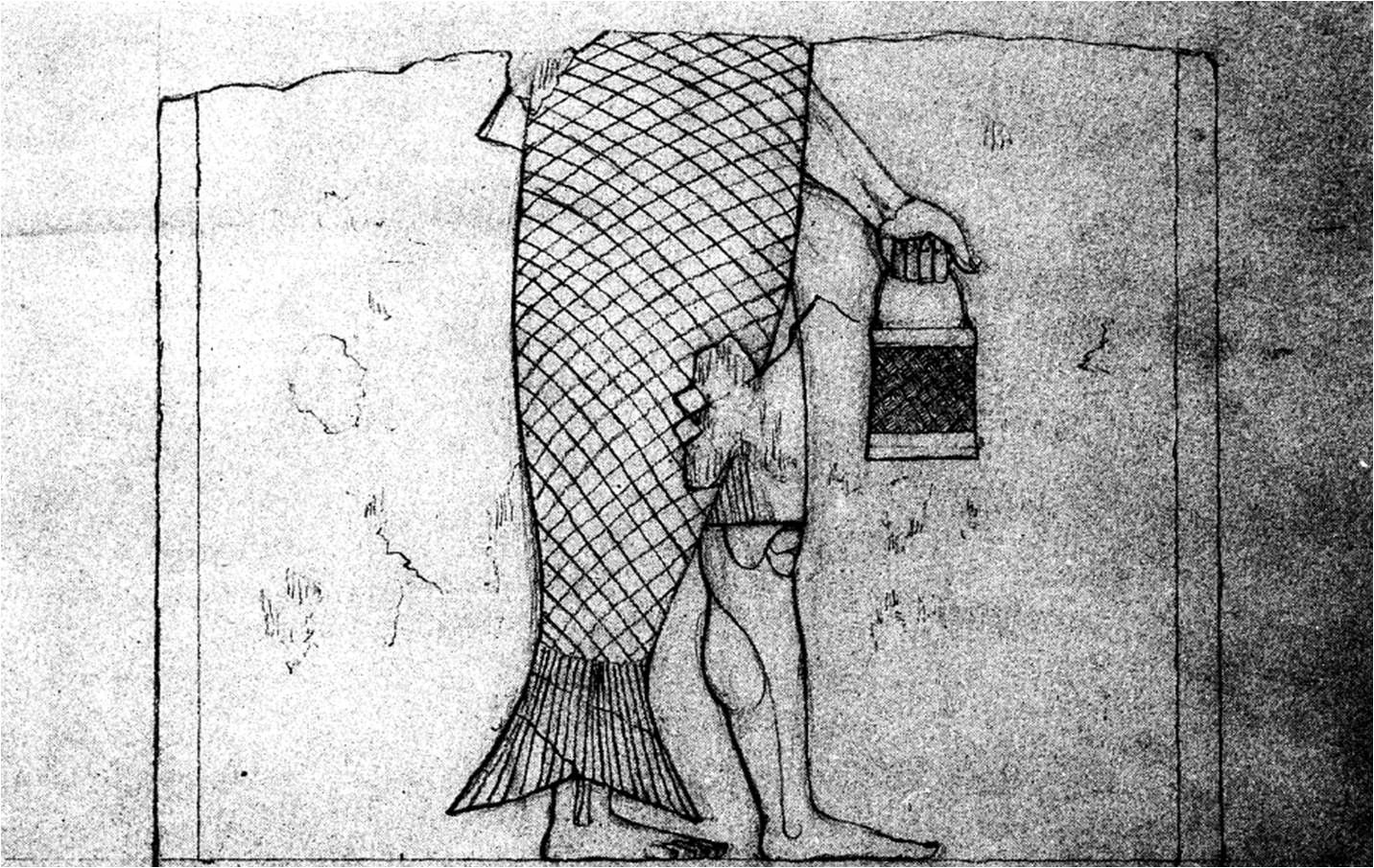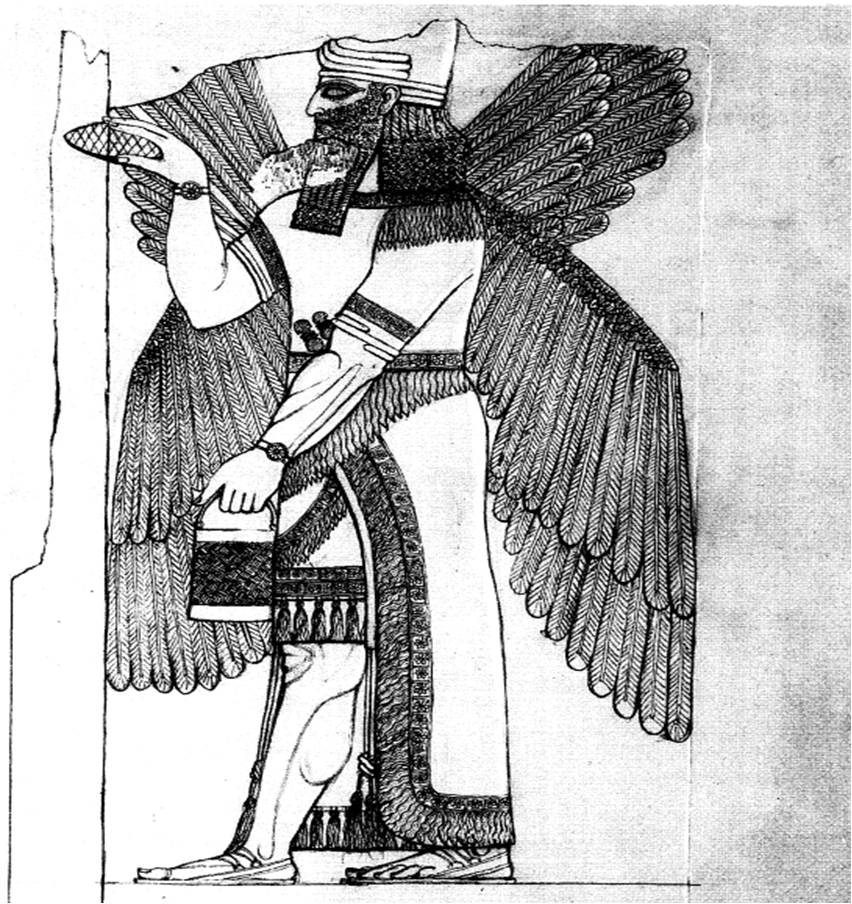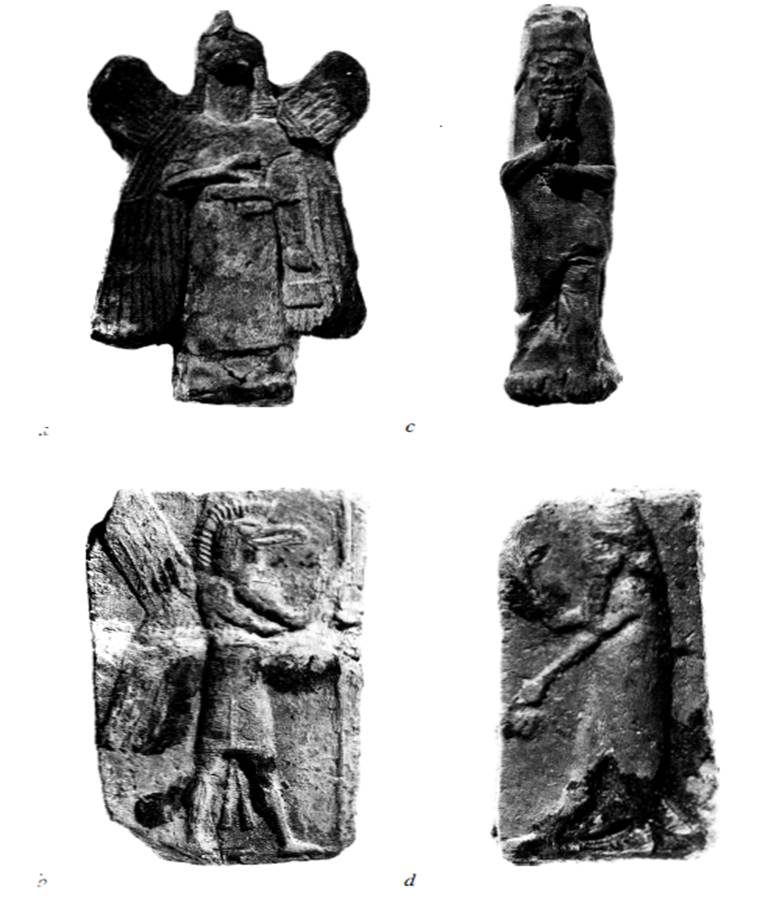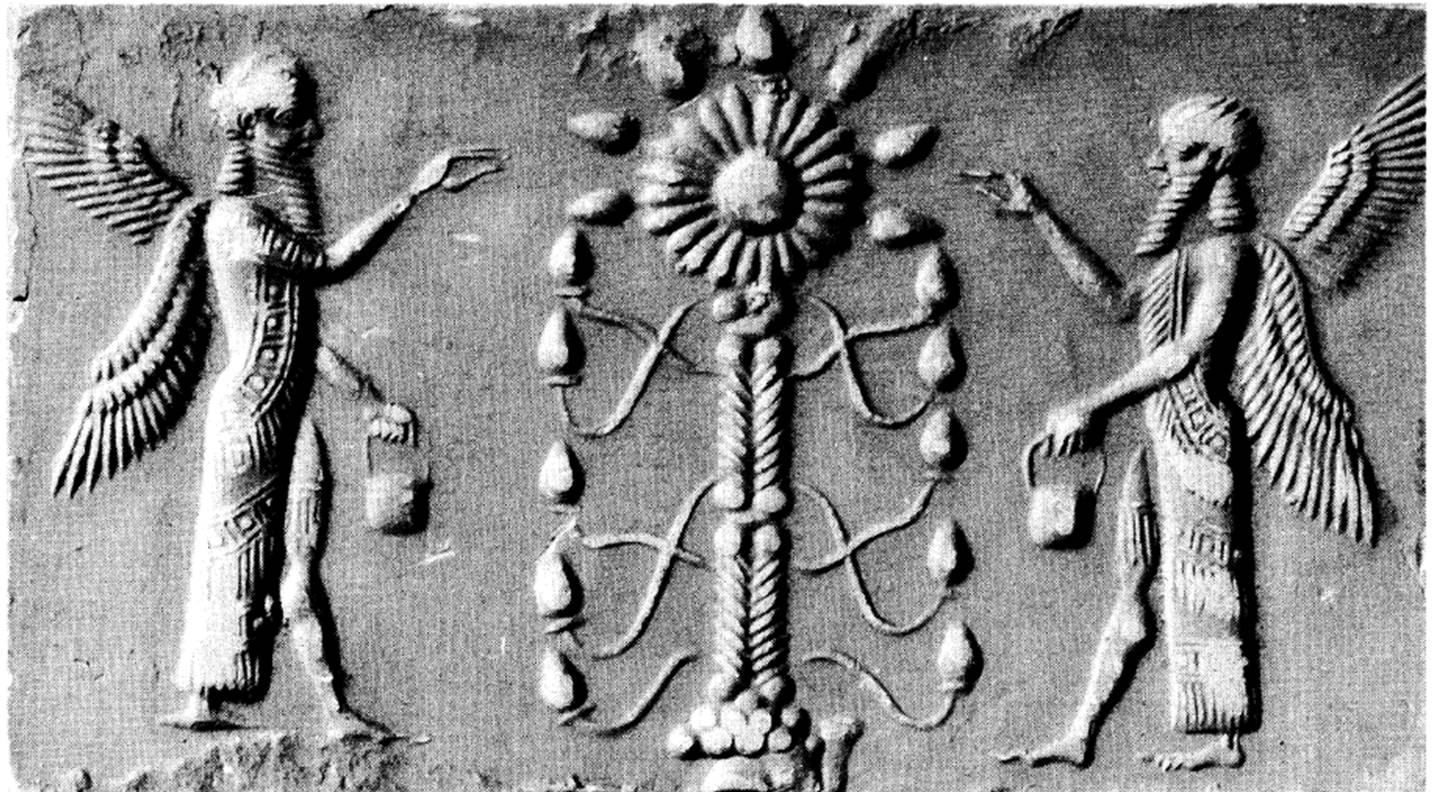The Scholars as the King's Spiritual Guardians and Advisers
A "Catalogue of Texts and Authors" from the library of Assurbanipal provides detailed information on contemporary ideas about the origins of the scholarly tradition.[[16]] Several important collections of scholarly lore are in this text explicitly attributed to Ea, the god of wisdom.[[17]] The other compositions listed in the text, covering a wide range of scientific, philosophical and religious works, are assigned either to legendary sages (apkallu) or to historical scholars (ummânu), who regularly turn out to be representatives of the Five Disciplines.[[18]] It is worth noting that some of the compositions attributed to human authors are said to have been revealed to them in a vision, and thus, in the final analysis, also were of divine origin.[[19]]
The Mythical Sages
The catalogue highlights two fundamentally important aspects of the Mesopotamian scholarly lore: its divine and inspired origin, making it a collection of sacred writings comparable to the Holy Writ, and the special role of mythical sages as unfolders of divine wisdom to humanity, described as follows in the Babyloniaka of Berossus (3rd century B.C.):
Oannes is the Greek rendering of Uanna, the first in a series of altogether seven antediluvian sages noted for their superhuman wisdom and referred to in cuneiform sources as "the seven counselors,"[[21]] "the seven shining sages, carp-fish from the sea,"[[22]] and "the seven sages of the Apsû, the pure carp-fish, who have been endowed with sublime wisdom like their lord Ea."[[23]] The fish-shape attached to them in the Tradition symbolized their mystical contact with the divine Ocean of Wisdom, Apsû, which they, unlike humans, were able to "plunge into" at will.[[24]]
After the Flood, the Tradition lists "four sages of human descent whom the lord Ea endowed with broad understanding";[[25]] the last of these, however, is only "two-thirds a sage," marking the transition from semidivine sages to human scholars, who from this point on appear as the guardians of the Tradition. A late first-millennium text listing seven antediluvian kings and one postdiluvian king with their "sages," and then continuing with historical kings and their "scholars," leaves no doubt that the latter were regarded as the linear successors and counterparts of the mythical sages.[[26]]
The difference between sages and scholars is thus not functional but qualitative. As pointed out by H.S. Kvanvig,[[27]] the distinction between the ante- and postdiluvian sages on the one hand, and the human scholars on the other, reflects the Mesopotamian concept of history as a succession of world eras of progressively deteriorating quality. In this process, man's years of life, which in the period before the Flood were counted in multiples of sars (3,600), were after the Flood reduced to multiples of ners (600), and then to their present length. To quote Kvanvig, "the period before the Flood was 'the history of revelation' in Babylonian theology. In this period the basis for all later knowledge was laid. Writings originating in this period would accordingly have a special authority ... the history which follows is the time when this revelation is transmitted and unfolded."[[28]] Accordingly, the role of the scholars can be defined as that of the transmitters and unfolders of received wisdom; they were the human successors of semidivine sages, whom they emulated but would and could not surpass in wisdom.
Adapa: the Paragon of Mesopotamian Scholarly Mysticism
One particular sage is frequently referred to in the present correspondence and in Neo-Assyrian royal inscriptions: Adapa, the last in the series of the seven antediluvian sages. His proverbial wisdom is reflected by his name, which literally means "born in the Sea (of Wisdom)"[[29]] and is attested in contemporary texts both as an adjective meaning "wise" and a word for "sage" in general.[[30]] The Tradition knew him as a pious servant of Ea "who ascended to heaven." He is thus the Mesopotamian counterpart of Enoch, the Biblical patriarch who "walked with God" and was taken to heaven for his piety (Gen. 5:23f).
A myth explaining Adapa's admission to heaven introduces him as a man created by Ea as a model for mankind,[[31]] a sage of superhuman wisdom, a lustration priest of pure hands, who performs all rites perfectly. He does the fishing for Eridu (the holy city of Ea), manoeuvring his boat without rudder and steering pole. In the open sea, he breaks the wing of the south wind and, following the advice of Ea, ascends to heaven dressed in a mourning garb. This, he explains, he wears because two gods, Dumuzi and Ningišzida, the keepers of the gate of heaven, have disappeared from his country.[[32]]
I have argued elsewhere that the ascent to heaven in this myth, as in the myth of Etana, is an allegory for mystical ascent of the soul.[[33]] As in the legend of Oannes discussed above, the "sea" which Adapa frequents in his "boat lacking rudder and steering pole," is Apsu, the transcendent Ocean of Wisdom. Adapa's "purity" is purity from sin; "breaking the wing of the south wind" is an allegory for triumph over the ego ; the "mourning garb" he wears is an expression for his sorrow over the spiritual state of his country, and it is through the incessant weeping occasioned by this sorrow that the "ascent to heaven" is granted to him.[[34]]
Seen in this light, Adapa emerges as a paragon of the later Jewish mystical scholar, a saintly man able to retrieve supernal knowledge through mystical union with God.[[35]] One should note that though included among the seven sages, Adapa of the myth is a member of the human race (zēr amīlūti). He achieves his "ascent" to heaven as a mortal, and, through the sagacity of Ea (who forbids him to accept the bread and water of life), is able to return from his 'trip' dressed in "divine garb" and equipped with extraordinary theurgic powers,[[36]] thus setting an example for later followers. Since the myth explicitly tells he was created as "a model for mankind," it can with good reason be assumed that his example was followed by many a Mesopotamian scholar, including the authors of the present letters.
The Watch of the King
In Assyrian iconography, mythical sages are represented as three kinds of composite creatures symbolizing their supernal wisdom and saintliness crystallized in the figure of Adapa: as fish-cloaked men, as eagle-headed winged creatures with human bodies, and as winged human figures wearing horned crowns (Frontispiece, Figs. 2-4).[[37]] As already noted, the fish-garb symbolized their connection with Apsû, the Ocean of Wisdom. The head and wings of the eagle symbolized their connection with heaven;[[38]] and the horned crowns, indicating divine status, symbolized their transformation from humans to saints after death. Ritual texts state that the sages were dressed in white garments, clearly symbolizing the purity of their souls.[[39]] These representations recall the transformed celestial appearance of Enoch in Jewish mystical tradition.[[40]]
Small statues of sages made of clay and wood were extensively used in Assyrian prophylactic rituals as a means to prevent evil demonical forces from entering a man's house (Fig. 5).[[41]] On Neo-Assyrian palace reliefs and seals, representations of sages are invariably associated with the Tree of Life and/or the king, whom they sprinkle with the cone-shaped "purifiers" (mul-lilu) and buckets of holy water (bandudû) they hold in their hands (Figs. 3, 4 and 6).
In the prophylactic ritual Bīt mēseri, where the sages figure prominently, they are said to "insure the correct functioning of the plans of heaven and earth" (uṣurāt šamê u erṣeti, Sum. giš.hur an.ki.a), i.e., the divine world order.[[42]] This passage is of central significance to the interpretation of the Sacred Tree scene. It will be remembered that the Tree symbolized both the divine world order and the king, who functioned as its earthly administrator (see above, p. XV). By "purifying" the Tree, i.e., keeping it clean from sin and imparting to it their own sanctity, the sages upheld the cosmic harmony and thus "insured the correct functioning of the plans of heaven and earth."

FIG. 2. Apotropaic figure, a fish-cloaked apkallu, on a wall-panel in the Palace of Sennacherib at Nineveh. ORIGINAL DRAWING IV. 76

FIG. 3. Apotropaic eagle-headed apkallu purifying and protecting the king, on a wall-panel from the Palace of Assurnasirpal at Nimrud, about 875 BC. BM 124585.
Another formulation of the same idea is encountered in the Erra epic, where the sages are called "the cleansers" of Marduk's body (mubbibū zumrīja, Erra I 162). The "body" of Marduk here refers to the Tree as to holon, "the totality of gods" making up the cosmic image of Marduk.[[43]]

FIG. 4. Apotropaic figure, probably an apkallu, on a wall-panel in the Palace of Sennacherib at Nineveh. ORIGINAL DRAWING I, 47.
Since the scholars emulated the role of the sages, the Tree of Life scene can also be interpreted as a symbolic representation of their activity at court. In this interpretation the Tree becomes the king, whose spiritual and moral integrity the scholars maintain and protect with their piety and wisdom.
The idea of royal protection, central to all activity of the scholars, finds expression in the phrase maṣṣartu ša šarri naṣāru, "to keep the king's watch," which recurs frequently in the letters.[[44]] A plain rendering is incapable of expressing the full meaning of the phrase, which involved watching, guarding and protecting the king, not so much from physical danger, but from straying from the path that the gods had decreed.
This the court scholars did by watching for and interpreting the signs that the gods sent and advising the king how these signs should be reacted to; by guarding the king's behaviour in cultic and other areas to prevent him from becoming culticly impure or from performing some task on an inauspicious day; by protecting the king from portended evil and divine wrath through apotropaic rituals and chants to avert the evil and appease the angered god; and, finally, by restoring the harmony between the king and the gods through ritual purification ceremonies that removed the king's sin and cleansed his persona of the evil thought or deed that had caused the sign to be sent.[[45]] To protect the king against making wrong decisions, the divine will was regularly consulted, through extispicy, in matters of national importance.

FIG. 5a-d. Apotropaic clay figurines and plaques for burial below floor. a-b) winged eagle-headed apkallus; c-d) fish-cloaked apkallus. BM 90992, BM 129096, BM 90997, BM 133034.

FIG. 6. Human-headed apkallus purifying the sacred tree in a Neo-Assyrian seal impression. BM 89307.
These duties were carried out by scholars working together in close cooperation and organized into professional teams, each headed by an eminent "chief."[[46]] The most important of these, the chief scribe, held a position in the Assyrian cabinet as the king's personal scholar (ummânu).[[47]]
The prophylactic function of the scholars was complemented by their advisory function, corresponding to the role of the seven sages as advisers (muntalkū) of the antediluvian kings. Virtually every letter of the present correspondence contains some advice or suggestion put forward to the king, and several letters make it plain that the king took receiving these suggestions and advice for granted.[[48]]
16 See W.G. Lambert, JCS 16 (1962) 59ff.
17 See ibid. p. 64, K 2248:1-4. The collections (listed right at the beginning of the text) include exorcists' lore, chanters' lore, the astrological omen collection Enūma Anu Enlil, the physiognomic omen collections Alandimmû and Kataduqqû, the diagnostic work Sakiqqû, the anomaly omen collection, and the two bilingual Ninurta epics, Lugale and Angimdimma.
18 According to the text, the Epic of Gilgamesh was redacted by the exorcist Sin-leqe-unninni, the Fable of the Willow by the exorcist Ur-Nanna, a scholar of Babylon. Of the 14 scholars figuring in the extant text, 5 are chanters, 1 is a diviner, and 7 are exorcists.
19 Cf. p. XIX on the 'heavenly ascent' of Adapa, and note that two compositions attributed to Adapa ([ud.sar an den.lí]l.lá and gá.e.me.en den.líl.l[á]) are explicitly ascribed to a visionary experience in the catalogue.
20 S.M. Burstein, The Babyloniaca of Berossus (SANE 1/5, Malibu 1978), p. 155f.
21 Gilg. I 15 and XI 305.
22 E. Reiner, "The Etiological Myth of the Seven Sages," Or. 30 (1961) 4:5-6.
23 Erra I 162.
24 Cf. M. Idel, Kabbalah: New Perspectives (New Haven and London 1988), p. 67f: "In principle, the great endeavour of the mystic is to attain the state of union without, nevertheless, being absorbed and lost in the divine abyss. Sinking is envisioned here as a perilous possibility inherent in the unitive experience."
25 R. Borger, "Die Beschwörungsserie Bīt mesēri und die Himmelsfahrt Henochs," JNES 33 (1974) 192; see also Reiner, Or. 30 (1961) 3:30f.
26 BaM Bh 2 no. 89, edited by J. van Dijk, UVB 18 (1962) 47f.
27 H.S. Kvanvig, Roots of the Apocalyptic, Volume I: The Mesopotamian Background of the Enoch Figure (Oslo 1984), pp. 210 and 217.
28 Ibid. p. 210.
29 In the tradition represented by Bīt mesēri (Borger, JNES 33 193f), the name of Adapa appears in the variant form Utuabzu, where the point about the "Sea" being the Ocean of Wisdom is made explicit.
30 See CAD s.v. adapu and S.A. Picchioni, Il Poemetto di Adapa (Budapest 1981), p. 99f.
31 I consider the traditional reading rid-di "example" more likely than šid-di "genie" (Picchioni, Adapa p. 127).
32 See S.M. Dalley, Myths from Mesopotamia (Oxford 1989), 182ff.
33 See JNES 52 (1993) 198ff.
34 On the technique of weeping used to achieve visionary experiences in Jewish mysticism see Idel, Kabbalah above, n. 10), pp. 75ff, and my remarks in JNES 52 195ff.
35 See. e.g., Idel, Kabbalah (above, n. 10), pp. 91ff, and JNES 52 173 n. 57 and 195 n. 129ff.
36 Picchioni, Adapa, p. 123:9ff. Cf. Idel, Kabbalah, p. 88ff.
37 See F.A.M. Wiggermann, Mesopotamian Protective Spirits (Groningen 1992), p. 65ff.
38 See my discussion of the Etana Myth in JNES 52 (1993) 197ff.
39 See Wiggermann, op. cit., p. 15, and commentary on LAS 197 in LAS II.
40 See J. Dan, Three Types of Ancient Jewish Mysticism (Cincinnati 1984) p. 15f, paraphrasing Sefer Hekhalot, probably written in Babylonia in the fifth century A.D. or later.
41 See Wiggermann, op. cit., passim.
42 See Reiner. Or. 30 (1961) 4:5-6 and Borger, JNES 33 (1974) 193.
43 See JNES 52 (1993) 173 n. 56 for the Tree as the image and cosmic body of God, and ibid. 187 n. 97 for the Assyrian phrase (gabbi) ilāni referring to God as the sum total of "(all) gods." Marduk is attested as the "sum total of gods" in the Neo-Babylonian text CT 24 50.
44 Note especially "I/we keep the watch of the king." nos. 118 r. 8. 143 r.4, 163:5-6, 164:7, 173 r.1, 334 r.11.
45 Cf. nos. 29 and 352. and see the comments on the former text in LAS II p. 335 and my remarks in "Mesopotamian Astrology" (above, n. 5), p. 54f.
46 Akkadian rab (lit., "the greatest") followed by the professional title in genitive. Aramaic and rabbinical Hebrew rab "chief, master, teacher, rabbi" are, despite Kaufman, AS 19 p. 87, loans from the Akkadian word.
47 See JNES 52 (1993) 168 n. 38 and the literature listed there.
48 See the letters listed in the glossary under malāku and milku, especially those of Akkullanu.
Simo Parpola
Simo Parpola, 'The Scholars as the King's Spiritual Guardians and Advisers', Letters from Assyrian and Babylonian Scholars, SAA 10. Original publication: Helsinki, Helsinki University Press, 1993; online contents: SAAo/SAA10 Project, a sub-project of MOCCI, 2021 [http://oracc.org/saao/saa10/scholarsasguardians/]